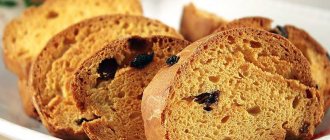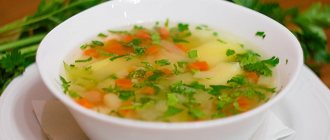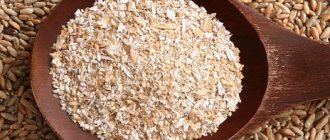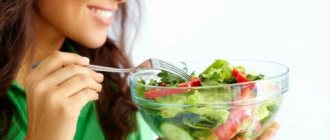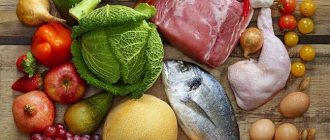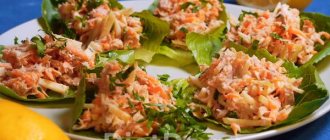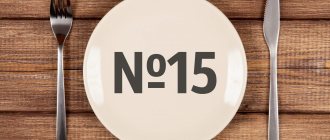Chemical composition and energy value of dietary table No. 14
Protein: 85–90 g (including approximately 45% animal protein). Fats: 70–80 g (including at least 30 g of vegetable fats). Carbohydrates: 300–350 g. Daily calorie content: 2,200–2,400 kcal. Free liquid: 2.5–3 l. Table salt: up to 6–8 g. Vitamins: retinol (A) – 0.6 mg, riboflavin (B2) – 1.9 mg, thiamine (B1) – 1.9 mg, nicotinic acid (B3) – 23 mg, ascorbic acid (C) – 130 mg. Macroelements: sodium - 4.4 g, potassium - 4.7 g, calcium - 0.9 g, phosphorus - 1.9 g, magnesium - 0.4 g. Microelements: iron - 30 mg. Optimal food temperature: from 15 to 65 degrees Celsius.
Daily norm of BZHU and diet
With this diet, the patient needs to consume up to 2800 kcal. Up to 80-100 g of proteins are included in the diet per day. Up to 60% of them should be of animal origin and 40% of plant origin. You need to consume up to 80-100 g of fat per day. The amount of carbohydrates is limited to 400-450 g. Salt consumption should not exceed 12 g. Drinking regime is required. Drink at least 2 liters of water per day. Food should be taken 4-5 times a day in small portions.
BJU consumption standards.
Recommended products and dishes of the diet table No. 14
Bread: any, a variety of flour products. Soups: based on weak low-fat meat broths with the addition of cereals or pasta. Meat dishes: any. Fish dishes: any. Side dishes: any water-based cereals; vegetables such as pumpkin and green peas are acceptable. Dairy products: excluded, except for sour cream in small quantities in dishes. Eggs: in any form up to 1 egg per day. Snacks: mushrooms, meat and fish snacks are allowed. Sauces: based on meat and mushroom broths. Sweet dishes: sour fruits and berries, jelly, confectionery, sugar, honey, fruit sorbets. Drinks: tea, coffee, fruit drinks, rose hip decoction. Fats: any, except animal fat, lard.
Simple recipes
This diet does not impose radical restrictions on the choice of products, so you can prepare both first and second courses. It is acceptable to consume some drinks prepared at home.
Garnish
In this case, you have to give up mashed potatoes, but peas can be a substitute. It's easy to prepare. First, rinse the peas, add water and leave for 2 hours. After this, it should be washed and placed on fire for 60 minutes. Periodically you need to remove the foam. After the peas are boiled, you need to crush them and add 1 tbsp. l. butter.
Meat and fish dishes
To diversify your diet, you can cook steamed meatballs. To do this you will need the following products:
- white rice - 100 g;
- minced chicken - 150 g;
- garlic - 1 clove;
- salt and pepper to taste.
First you need to cook the rice.
After it has cooled, add 150 g of minced chicken to the rice. Then you need to add salt, pepper and crushed garlic. From the resulting mixture you need to form cutlets. They can be cooked in a slow cooker, oven or steamer. Fish quenelles are another easy dish to make at home. First, 300 g of fish fillet is ground in a meat grinder. 100 g of soaked bread is added to the minced meat. The mass is well kneaded and quenelles are formed from it. Then 50 ml of low-fat sour cream is diluted with 1 liter of water. Place a bay leaf into the liquid and bring it to a boil. The quenelles are placed in the sauce and cooked for 25 minutes.
Soups
If you follow diet No. 14, you can prepare soup with meatballs at home. You will need the following products:
- vegetable broth - 1 l;
- minced beef - 350 g;
- vermicelli - 100 g;
- vegetable oil 4 tbsp. l.;
- carrots - 30 g;
- onion - 1 head.
The minced meat should be peppered and salted, and then formed into meatballs. Pour vegetable broth into the pan and bring to a boil. Onions and carrots are chopped into cubes and then fried in vegetable oil until golden brown. Cook the meatballs in boiling broth for 20 minutes. Then you need to add the frying and salt. Cook the soup for another 10 minutes until the soup is ready.
Sample diet menu No. 14
First breakfast: herring, buckwheat porridge, coffee. Second breakfast: liver pate, fruit drink. Lunch: chicken noodle soup, grilled chicken, rice, tea. Afternoon snack: jelly. Dinner: pumpkin casserole with meat, tea. At night: rosehip decoction.
Sources:
- Order of the Ministry of Health of the Russian Federation No. 330 “On measures to improve clinical nutrition in medical institutions of the Russian Federation” dated 05.08.2003
The essence of the diet
Table number 14 aims to stop the formation of phosphorus-calcium salt precipitate and change the urine reaction from excessively alkaline to acidic. Diet No. 14 satisfies the patient’s physiological needs for energy and nutrients.
Energy content varies between 2100-2700 calories, while increased consumption of vitamins is provided. While following a therapeutic diet, you need to monitor the amount of food you eat, since using the menu for more than one week can add a couple of extra pounds.
Chemical composition of the daily diet:
- Carbohydrates – 350-400 grams;
- Proteins – 65-80 grams (mainly of animal origin);
- Fats – 80-90 grams.
Table number 14 for urolithiasis has no restrictions on the use of sodium sulfate. The daily amount of salt is standard – 10-12 grams.
The volume of free liquid intake must always be kept under control - a person should not be allowed to drink less than the 2-2.5 liters prescribed in the diet.
Dish recipes
There are no restrictions on the heat treatment of products, as well as requirements for the temperature of ready-made dishes. Diet number 14 allows for boiling, stewing, baking and frying until golden brown and appetizing.
Grechaniki
Ingredients:
- 500 grams of turkey fillet;
- 200 grams of buckwheat;
- 2 eggs;
- 50 grams butter
- A pinch of salt.
Preparation:
Sort out the buckwheat and boil in salted water. Grind the meat in a meat grinder and mix with buckwheat. Beat the eggs into the minced meat, add a little salt and mix thoroughly. Form cutlets and fry in a frying pan with melted butter for 4-5 minutes on each side.
Redcurrant jelly
Ingredients:
- 250 grams of red currants;
- 50 grams of sugar;
- 15 grams of gelatin.
Preparation:
Pour gelatin with a glass of boiled water at room temperature and leave until it swells. Remove the stems from fresh currants and grind through a sieve. Using gauze, strain the resulting pulp. Place the freshly squeezed juice on the table for a while, and the puree on the stove. Slowly bring the currant mixture to a boil, add sugar and simmer until it is completely dissolved. Heat the juice together with gelatin until a homogeneous consistency is obtained. Mix the puree with juice, let cool, pour into molds and place in the refrigerator for 2-3 hours.
Diet table No. 14 for children and adults, if strictly followed, gives good results. But in addition to adjusting the diet, treatment of the urolithiasis system should be supported by medication and physiotherapy, and sanitary and resort treatment.
THESE ARTICLES WILL HELP YOU LOSE WEIGHT
Who is assigned table 14
Table No. 14 is prescribed to people who have stones made from phosphate salts in their urinary organs. The basis of this disease is a violation of material metabolism. The pathology is accompanied by pain, the presence of blood in the urine, nausea and vomiting.
The therapeutic diet is aimed at stopping the formation of phosphorus-calcium sediment and correcting urine in the acidic direction. If, in addition to urolithiasis, a person suffers from obesity or atherosclerosis, he will need table adjustments. This issue should be addressed by the attending physician.
Basic principles
Energy value ranges from 2100 to 2700 calories per day. The chemical composition of the diet is as follows:
- fats – from 80 to 90 g;
- carbohydrates – from 300 to 400 g;
- proteins – from 65 to 80 g.
There are other rules for following the diet:
- The daily salt intake is 10-12 g.
- You are supposed to drink 2-2.5 liters of liquid. Increased amounts of water remove calcium salts in the urine.
- There are no special conditions for cooking methods.
- Last meal a couple of hours before bedtime.
The duration of dietary therapy should be determined by the attending physician, taking into account the results of the analysis, which monitors the acidity of the patient’s urine.
"Sour" menu
Diet table No. 14 does not have any specific menu - the diet is compiled and adjusted individually, using the list of permitted products and taking into account the degree of development of the disease.
Sample menu for the week:
Monday
- Breakfast: buckwheat porridge with meat gravy, oat broth;
- Lunch: a glass of lingonberries;
- Lunch: fish soup, lentil and pea puree;
- Afternoon snack: sandwich with sausage, sea buckthorn juice;
- Dinner: boiled squid with rice side dish.
Tuesday
- Breakfast: millet porridge with soft-boiled egg, tea with lemon;
- Lunch: baked pumpkin;
- Lunch: meat broth, dumplings with butter;
- Afternoon snack: meringue, rosehip decoction;
- Dinner: krupenik with minced meat, apple and lemon juice.
Wednesday
- Breakfast: pasta with butter;
- Lunch: sour berry jelly;
- Lunch: rice soup with pieces of beef, pea puree;
- Afternoon snack: marshmallows, homemade lemonade;
- Dinner: sweet pilaf with prunes, wheat bran decoction.
Thursday
- Breakfast: protein omelet, gooseberry decoction;
- Lunch: a glass of red currants;
- Lunch: chicken soup with pasta, boiled beef with rice;
- Afternoon snack: meringue, cranberry juice;
- Dinner: meat soufflé with noodles, apple compote.
Friday
- Breakfast: wheat porridge with fish quenelles, pomegranate juice;
- Lunch: apple-pumpkin pudding;
- Lunch: sea bass chowder, meatballs in tomato sauce;
- Afternoon snack: lingonberry pie, oat broth;
- Dinner: grilled cod, red currant juice.
Saturday
- Breakfast: oatmeal and sour apple;
- Lunch: steamed viburnum with honey;
- Lunch: shrimp soup, turkey cutlets;
- Afternoon snack: oatmeal cookies, lingonberry juice;
- Dinner: baked mackerel with permitted vegetables.
Sunday
- Breakfast: rice porridge with chicken cutlet, wheat bran decoction;
- Lunch: pumpkin-sea buckthorn puree, bread with butter;
- Lunch: mushroom soup, a piece of oven-baked duck;
- Afternoon snack: biscuits, bread kvass;
- Dinner: pork chop with green peas, apple juice.
It is recommended to drink natural sour-mineral water on an empty stomach and between meals.
Menu for children
Diet number 14 for children does not differ much from the diet for adults - exactly the same products remain permitted, and the same ones are prohibited.
The baby's menu should consist of all kinds of cereals cooked in water, meat and fish products. Vegetables and fruits allowed by the diet should be present in the diet daily.
Daily menu option for children:
- Breakfast: buckwheat porridge with apple, sweet tea;
- Lunch: steam omelette, wheat bran decoction;
- Lunch: soup with chicken meatballs, pancakes with condensed milk;
- Snack: stewed carrots with butter;
- Dinner: boiled fish, lingonberry juice.
Products such as vegetables, fruits, milk and its derivatives in everyday life are the basis of the diet of a growing organism. With their limitation, children's immunity decreases, which is why it is so important to maintain high physical activity, avoid stressful situations and hypothermia.



